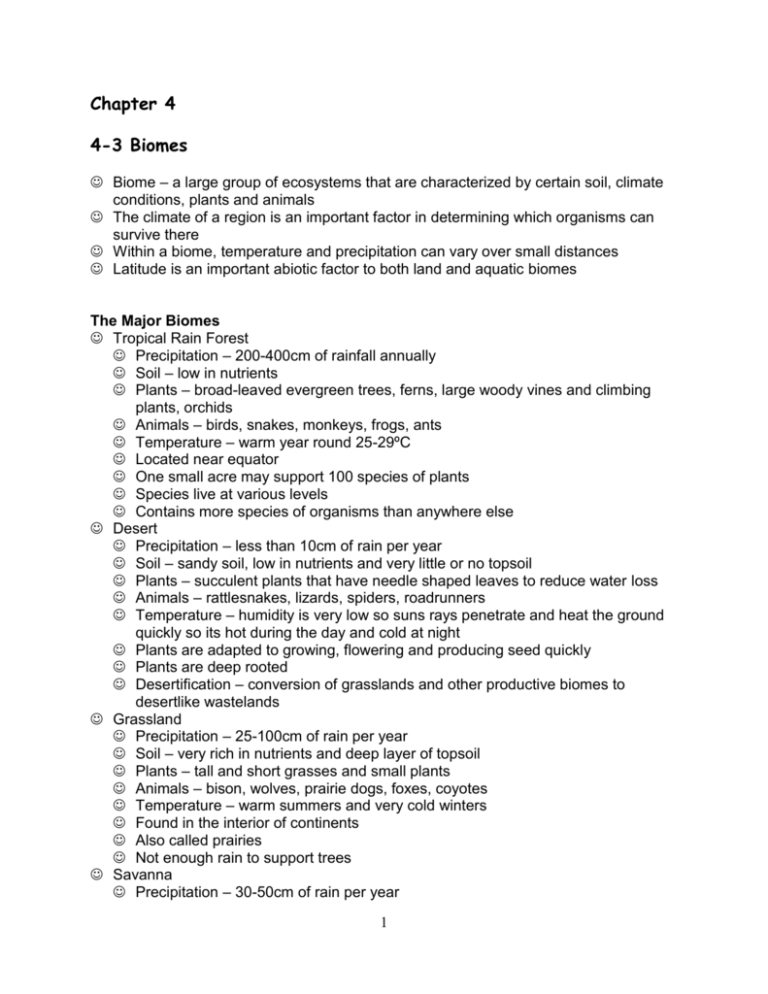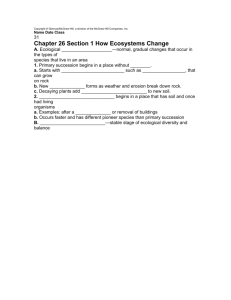Chapter 4 Notes - Kenton County Schools
advertisement

Chapter 4 4-3 Biomes Biome – a large group of ecosystems that are characterized by certain soil, climate conditions, plants and animals The climate of a region is an important factor in determining which organisms can survive there Within a biome, temperature and precipitation can vary over small distances Latitude is an important abiotic factor to both land and aquatic biomes The Major Biomes Tropical Rain Forest Precipitation – 200-400cm of rainfall annually Soil – low in nutrients Plants – broad-leaved evergreen trees, ferns, large woody vines and climbing plants, orchids Animals – birds, snakes, monkeys, frogs, ants Temperature – warm year round 25-29ºC Located near equator One small acre may support 100 species of plants Species live at various levels Contains more species of organisms than anywhere else Desert Precipitation – less than 10cm of rain per year Soil – sandy soil, low in nutrients and very little or no topsoil Plants – succulent plants that have needle shaped leaves to reduce water loss Animals – rattlesnakes, lizards, spiders, roadrunners Temperature – humidity is very low so suns rays penetrate and heat the ground quickly so its hot during the day and cold at night Plants are adapted to growing, flowering and producing seed quickly Plants are deep rooted Desertification – conversion of grasslands and other productive biomes to desertlike wastelands Grassland Precipitation – 25-100cm of rain per year Soil – very rich in nutrients and deep layer of topsoil Plants – tall and short grasses and small plants Animals – bison, wolves, prairie dogs, foxes, coyotes Temperature – warm summers and very cold winters Found in the interior of continents Also called prairies Not enough rain to support trees Savanna Precipitation – 30-50cm of rain per year 1 Soil – compact soils Plants – grasses, scattered trees Animals – lions, cheetahs, elephants, giraffes, zebras, ostriches, rhinoceros Temperature – warm year round, 24-29ºC Woodland and Shrubland Precipitation - 25-60cm of rain per year Soil – low in nutrients and highly acidic Plants – hardened tough evergreens, wildflowers, grasses Animals – coyotes, foxes, bobcats, mountain lions Temperature – hot dry summers with periodic fires and cool moist winters Western or southern coastal region Also called chaparral in areas dominated by shrubs Deciduous Forest Precipitation – 70-200cm of rain per year Soil – moist and fertile, rich in humus (decaying leaves and other organic matter) Plants – birch, maple, oak, elm, evergreens Animals – deer, foxes, raccoons, squirrels, birds Temperature – warm during the summer and cold in the winter, 0-30ºC Deciduous Trees – lose their leaves annually ¼ of bird species Coniferous (Taiga) Forest Precipitation – 30-70cm of rain per year, frequent droughts Soil – low in nutrients and highly acidic Plants – cone bearing trees, pines, firs, spruces Animals – moose, bears, timberwolves, migratory birds Temperature – warm during the summer and cold in the winter Needle shape leaves is adaptation for water loss Lies south of the tundra Tundra Precipitation – 20-60cm of rain per year Soil – thin moist and nutrient poor Plants – mosses, lichens, and grasses that survive in soggy soil Animals – caribou, reindeer, artic fox Temperature – cool in summer and freezing in winter Permafrost – permanently frozen ground Treeless land Long summer days and short periods of winter sunlight 4-4 Aquatic Ecosystems Nearly ¾’s of the Earth’s surface is covered with water Aquatic ecosystems are often grouped according to the abiotic factors that affect them. The depth of water determines the amount of light that organisms receive Communities of organisms found in shallow water close to shore can be very different from the communities that occur away from shore in deep water 2 Freshwater Ecosystems Flowing-Water Ecosystems Rivers, streams, creeks, and brooks Originate in mountains or hills 3 Types of Stream Habitats 1. Riffle Shallow Water flows swiftly over rough bottom of sand and rock 2. Pools Deep water flows slowly over smooth bottom 3. Runs Smooth surface but fast flowing water Standing-Water Ecosystems Lakes and ponds A Lake has 3 Zones 1. Littoral All around the shore Water is shallow and well lit Diversity is greatest 2. Limnetic Open water Sunlit water that extends to where photosynthesis takes place Plankton, diatoms, green algae 3. Profundal Open water Below depth of photosynthesis Bacterial decomposers Lakes show seasonal changes in temperate regions Spring Overturn DO from the surface moves to deep water and nutrients released by decomposition moves to surface Fall Overturn Upper layer cools becomes denser then sinks DO moves down and nutrients move up Oligotrophic Lake Nutrient poor and oxygen rich Deep lake with few phytoplankton Eutrophic Lake Nutrient rich and oxygen poor Has a high rate of biological productivity Freshwater Wetlands Wetland – water covers the soil or is present at or near the surface of the soil at least part of the year 3 3 Types of Freshwater Wetlands 1. Bog – wetland that form in depressions where water collects 2. Marsh – shallow wetland along river 3. Swamp – look like flooded forests, water flows slowly Estuaries Estuary – a place where salt water mixes with fresh water The salinity of an estuary changes with the tides so a large range of salt tolerant organisms live there Mangrove – coastal wetland that occur in bays and estuaries across tropical regions In southern Florida and Hawaii Dominant plants are salt-tolerant trees, called mangrove Marine Ecosystems Intertidal Zone Portion of the shoreline between the high and low tides High levels of sunlight, nutrients, and oxygen but productivity may be limited by waves crashing against the shore Organisms that live here have to be adapted to changing conditions Benthic Zone Includes all sediments and rocks of the ocean bottom Starts at continental shelves and extends to deep sea trenches Pelagic Zone Full volume of ocean water Coral Reefs Found in tropical coastal water Named for the coral animals whose calcium carbonate skeletons make up their primary structure An extraordinary diversity of organisms flourishes among coral reefs Reef-building corals grow with the help of algae that live symbiotically within their tissues 4







